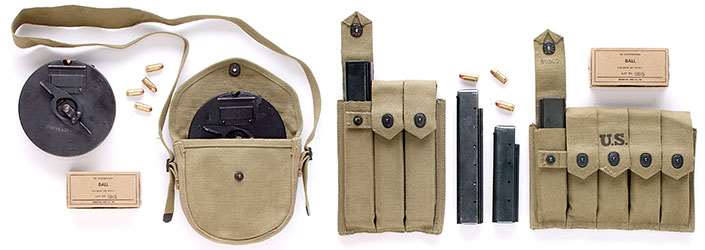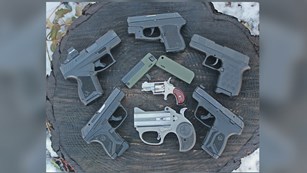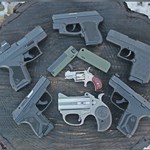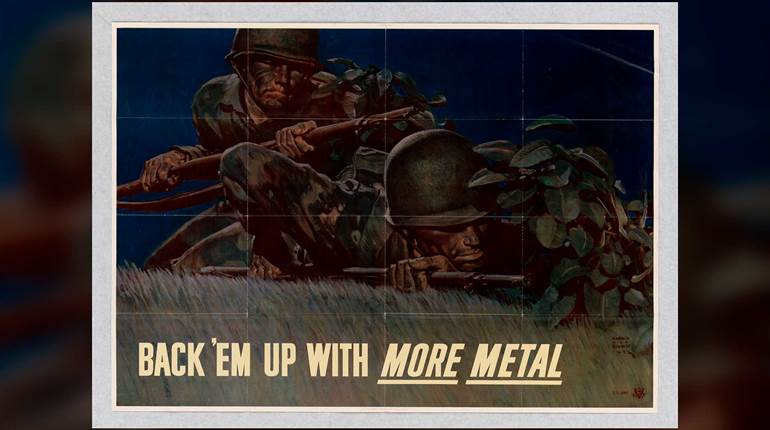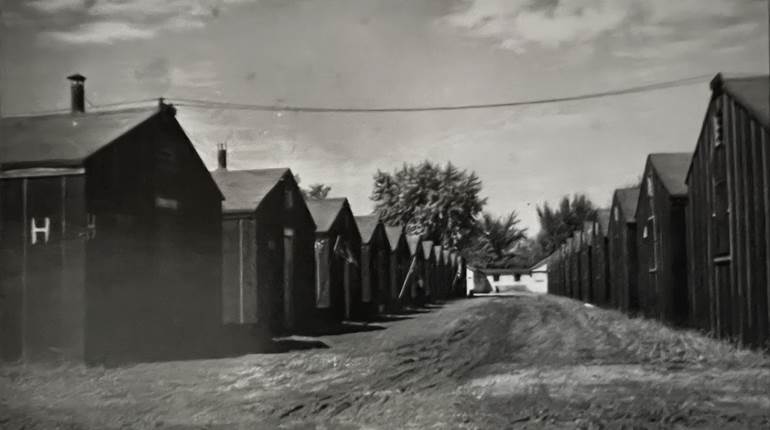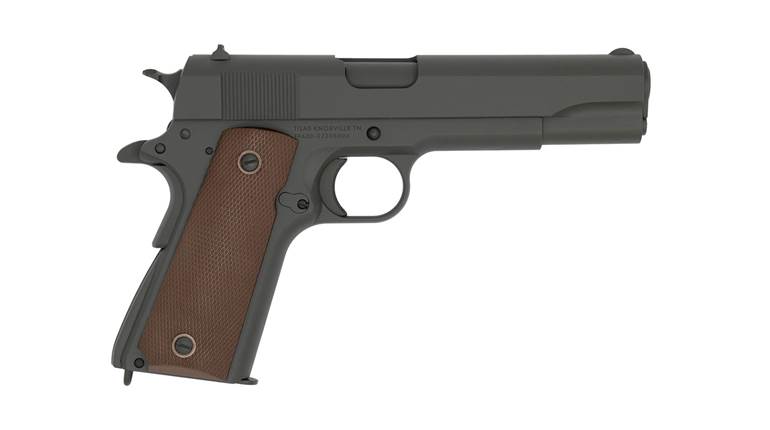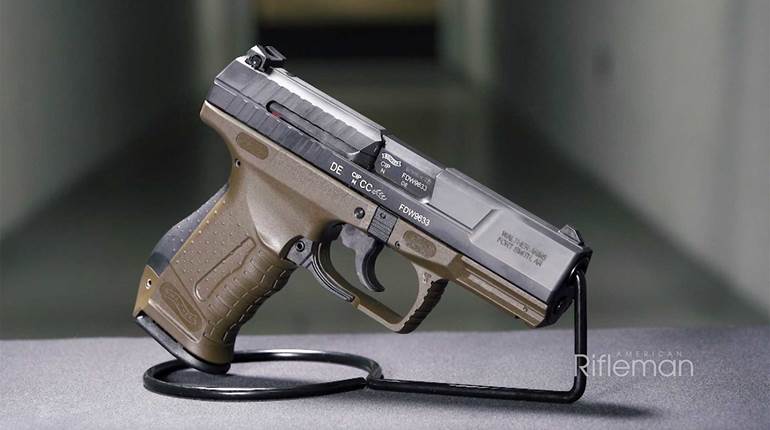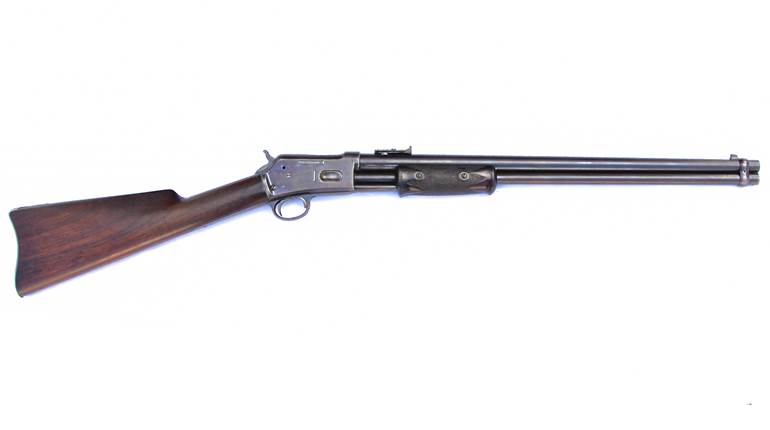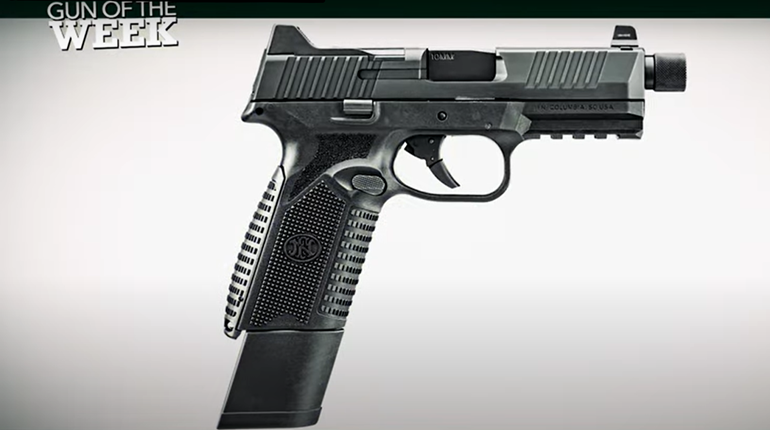
Taken on Okinawa in 1945, this iconic image depicts Marines armed with an M1 or M1A1 Thompson and an M1918A2 BAR.
One of the most iconic American firearms is the Thompson submachine gun. A staple of the Hollywood gangster movies in the 1930s, it is instantly recognizable to many people who otherwise know little about firearms. Nonetheless, the notoriety it garnered in the “Roaring Twenties” is only a small part of the Thompson story. The gun’s enduring legacy was earned in World War II, during which it proved to be a vital part of America’s small arms arsenal.
The first practical submachine gun, the German MP 18.1, was fielded during World War I. An American Army officer, Col. John T. Thompson (later a general), had foreseen the value of an arm with somewhat similar attributes—even before the MP 18.1 arrived on the scene. Thompson formed a commercial entity to develop and market such a gun, but the war ended before a prototype could be completed.
In 1920, Thompson’s company, Auto-Ordnance Corp., had a prototype ready, but the firm had no mass-production facilities. An agreement was reached with the Colt Patent Firearms Mfg. Co. to manufacture 15,000 Thompson submachine guns for Auto-Ordnance. The new gun, designated the Model of 1921, was introduced in 1921.
Naturally, Auto-Ordnance was seeking to have its unique new arm adopted by the U.S. military, but the timing couldn’t have been worse for Thompson and his organization. The American military had large inventories of rifles, automatic rifles, shotguns and machine guns after the end of World War I, and the U.S. Ordnance Dept. had no interest in another infantry arm.
Spurned by the U.S. government, Auto-Ordnance sought to market the Thompson to civilians, but a lack of demand resulted in few sales, due primarily to its price of $200 (almost $3,000 in 2019 inflation-adjusted figures) and its limited appeal to hunters and sportsmen. Thus, the bulk of the 15,000 Colt-made Thompson submachine guns languished in the warehouse with only a relatively small number trickling out periodically.

Although the American military had little interest in the Thompson, the U.S. Postmaster General purchased 200 to arm Marines posted to duty in 1926 to counter a rash of violent armed mail robberies. The Marines soon quelled the robberies, but they held on to the “Post Office” Thompsons. They took their Thompsons along to various hotspots around the globe in the late 1920s and early 1930s, including Nicaragua and China, where they proved to be very effective. In 1928, the Navy Bureau of Ordnance made a few changes to the existing Colt Model 1921 Thompsons acquired by the Marines, including the reduction of the rate of fire and the addition of a compensator on the barrel to improve controllability. The modified guns were marked “U.S. Navy / Model of 1928.”
Despite its successful use by the Marines, the Army was not interested in the Thompson as an infantry arm but thought it might have some application for cavalry use. The Thompson was tested at Ft. Riley, Kan., in February 1928, but the test results concluded: “[It is] an undesirable weapon, effective only at short range, is unnecessary and undesirable for the cavalry. Recommendations: The Board recommends that the Thompson Submachine Gun not be adopted for cavalry service.”
By late 1938, there were still some 4,700 unsold Colt-made Thompsons, and Auto-Ordnance was in dire financial straits, resulting in the sale of the company to a group headed by Russell Maguire. Maguire’s timing was excellent as, less than a year later, war erupted in Europe. Since the remaining inventory of the Colt-made Thompsons was dwindling, it was apparent the supply would not last long when allied nations came calling for guns from the United States. Since Auto-Ordnance still had no production facilities, Maguire made arrangements with the well-established firm of Savage Arms Corp. of Utica, N.Y., to manufacture Model 1928 Thompsons.
As Great Britain and other countries began placing orders for arms, Savage was inundated with requests for Thompsons. In order to supplement Savage’s production, Auto-Ordnance acquired what was formerly a brake shoe plant in Bridgeport, Conn., to manufacture Thompsons. Thus, just before America’s entrance into World War II, there were two companies, Savage and Auto-Ordnance, engaged in production of the Model 1928 Thompsons. This would soon prove fortuitous for the U.S. military.

In 1928, the Thompson was considered by the U.S. Army to be “unnecessary and undesirable,” but by 1941 the perception did an abrupt about-face. On the eve of America’s entry into World War II, the Army standardized the “Thompson Submachine Gun, Caliber .45, M1928A1,” and plans were being made for large-scale procurement of the guns.
When the United States became actively involved in the war after Pearl Harbor, the demand for all manner of arms, including submachine guns, increased dramatically. Auto-Ordnance and Savage engineers sought ways to increase the rate of production and reduce costs. For example, the early Model 1928A1 Thompsons had a finely adjustable Lyman rear sight. While great for a rifle, such a sight for a submachine gun was an unnecessary and expensive extravagance that did not increase its utility. The Lyman was replaced by a simple, non-adjustable, “L”-type, stamped-metal peep sight. Also, the fins on the barrel, which required a lot of machining, were deleted as they were not vitally essential for adequate cooling. The familiar vertical fore-end front grip was soon dropped in favor of a horizontal fore-end, which was more durable for military use.
During the early part of the war, two types of magazines were manufactured for the M1928A1: the 50-round rotary drum and the 20-round box magazine. Canvas pouches were procured to carry the magazines.

M1 Thompson Submachine Gun
Auto-Ordnance and Savage Arms continued to seek ways to further simplify the M1928A1. While the stamped-metal rear peep sight and the elimination of the barrel-cooling fins were certainly steps in the right direction, they were little more than cosmetic changes. One item that received a hard look was the signature feature of the Thompson’s mechanism, the Blish lock. This mechanism was incorporated into the original design at the insistence of John Thompson, even though key individuals on the production team at the time had doubts as to whether it was really necessary. Twenty years later, Savage engineers came to the same conclusion and felt that the relatively low pressures created by the .45 ACP cartridge did not require an extremely strong locking system and that the Thompson would function just as well with a straight blowback mechanism. The Blish lock was eliminated, which further reduced manufacturing time and cost.
In late February 1942, a prototype of the re-designed Thompson was submitted to the Ordnance Dept. The simplified gun performed very well in subsequent testing and, on April 24, 1942, the “Submachine Gun, Caliber .45, M1” was adopted. The following day, the Model 1928A1 Thompson was re-classified as “Limited Standard,” which meant that the guns already on hand could continue in use but no more of that type would be procured. The M1 Thompson had a slightly higher rate of fire than the M1928A1: approximately 700-800 rounds per minute.
Aside from the change in the design of the locking mechanism, there were a number of external differences between the M1 and M1928A1. The actuator handle on top of the receiver of the M1928A1 was replaced by a cocking handle re-located to the right side of the M1’s receiver. The M1 was not fitted with the Cutts Compensator, which was intended to aid in keeping the muzzle down when firing fully automatic. While it did help to some extent, it wasn’t judged to be of sufficient utility to warrant the expense. Other subsequent changes included the use of simple “pin-type” selector and safety levers to replace the previously milled components, which required more machining. Also, the M1 had a fixed buttstock rather than the removable type as found on the M1928A1.
These changes resulted in a significant decrease in the cost of the M1 model as compared to the M1928A1. On Feb. 24, 1942, Savage contracted with the Ordnance Dept. to manufacture the new model at a cost of $36.47 per gun. Auto-Ordnance’s contract price for the M1 Thompson was $42.94 each.

M1A1 Thompson Submachine Gun
The Savage engineering team that developed the M1 Thompson continued its efforts to further refine the gun. The M1 Thompson’s bolt contained a firing pin activated by a hammer that was released when the trigger was pulled. Savage devised a bolt with a projection machined directly on its bolt face that eliminated the need for the hammer and related parts. This resulted in an even simpler and less expensive mechanism. The revised gun was officially adopted on Oct. 29, 1942, and designated as the “Thompson Submachine Gun, Caliber .45, M1A1.” Externally, there were no differences between the M1 and M1A1 except for the markings on the receiver.
Neither the M1 nor M1A1 models had the provision for attachment of the 50-round drum magazine. In order to provide a magazine with a greater capacity than 20 rounds, a 30-round box magazine was developed that could be used with all three Thompson models. The 30-round magazine was identical to the 20 except for the increased length.
It has been stated that the drum magazine was only used early in the war and was dropped from use as the war progressed, as the drum was expensive, heavy and tended to rattle. While it did have all of these negative attributes, it also possessed the undeniable advantage of providing an impressive amount of firepower. World War II-vintage photographs refute the assertion that the 50-round magazine was dropped from field use later in the war. A number of images show drum-equipped M1928A1 Thompsons still being employed at least as late as June 1945 during the Battle of Okinawa.
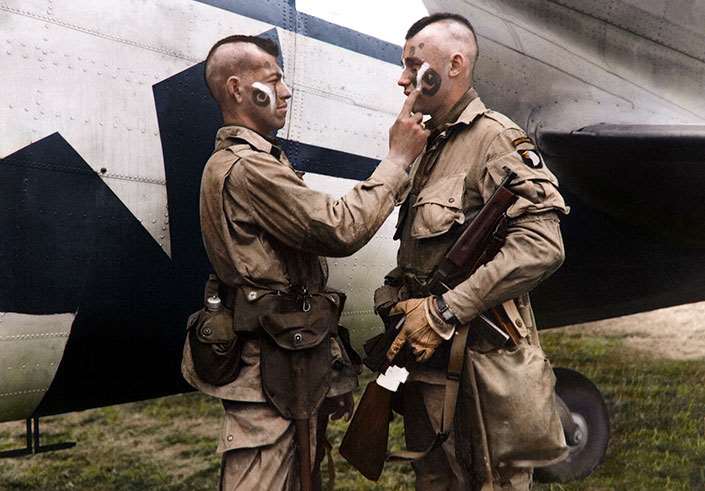
World War II Thompson Use
The Thompson’s first substantial American use in combat was during the invasion of Guadalcanal in August 1942 when M1928A1s, along with a number of Reising submachine guns, accompanied the Marines to the Solomon Islands.
As was the case with all infantry arms, some of the fighting men cherished the Thompson while others didn’t care for it. The two most common complaints regarding the Thompson were the lack of the .45 ACP bullet’s ability to penetrate brush and foliage (an important feature in jungle warfare) and the gun’s weight.
The Thompson’s lack of penetration power was echoed in an October 1943 Marine Corps report detailing the various arms used by a Raider Battalion on New Georgia Island:
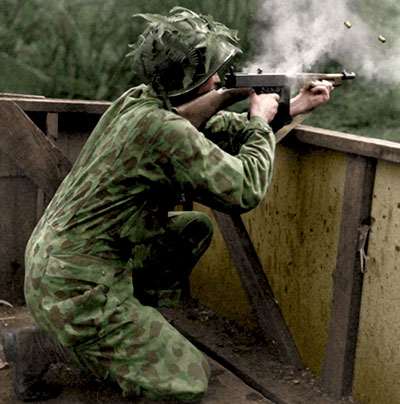
“Thompson Sub-Machine Gun, Cal. .45; Held up well on all operations with very little maintenance. There were some instances of jamming after a large volume of fire had been delivered. This weapon became extremely unpopular though, because of its poor penetrating power of trees, roots and dugouts, to anywhere near the degree of the .30 Cal. bullet, and this is vital in jungle warfare. It is suggested that this weapon in the squads be replaced with a .30 Cal. Automatic weapon.”
An even more scathing critique of the Thompson was conveyed in a report from Marine Corps Col. Victor H. Krulak, who attended an Army Ordnance Committee Meeting on Dec. 23, 1943, and discussed his views of various arms used by Marine Corps in the Pacific Theater: “[It] is much too heavy; it is uncomfortable to carry and it does not function well. I know the Russians like it, but I believe they just don’t know any better. It does not function well in the jungle. It does not stand up. That is a generality. I suppose I should expound on this a little bit. When I say, they do not stand up, they do not react well to the destructive effect of continued immersion. As you know, small arms consume quantities of powder which makes a dandy paste with water and sand, and presently the automatic function is destroyed.”

On the other hand, firsthand accounts of some soldiers and Marines paint an entirely different picture of the Thompson, as it was held in high regard by many of the men who used it in combat. For example, in the authoritative book on U.S. Marine Corps Raiders in World War II, Our Kind Of War, the comments regarding the Thompson were positive: “The Thompson submachine gun was a favorite of the Raiders, as it was rugged and reliable and fired the same readily available ammunition as used in the M1911A1 .45 pistol.”
Another combat veteran who held the Thompson in high regard was Charlie Feeback, who was drafted into the U.S. Army in 1943 and saw combat in the Philippines, New Guinea and Palau Island with the 24th Infantry Division. Feeback discussed his experiences with the Thompson in the book U.S. Infantry Weapons In Combat:
“I liked the Thompson; it was a good combat weapon. I kept a clip in the gun and two 30-round clips in a pouch. Then I had an extra canteen cover with one of those little waterproof bags that I carried extra .45 ammunition in.
“A lot of the fighting we did was at close range and the Tommy gun was the ideal weapon for that. Sometimes you were right on them and they’d pop up out of a hole at you … . The Tommy gun was great for close range; you didn’t have to be a good shot. If you needed to shoot way off, we had a couple of guys with sniper rifles and the M1s were pretty good for that too.
“[A]fter I was wounded in May 1945, I had to go back to the hospital on Leyte. When I came back to join my outfit, they gave me one of those grease guns. I wasn’t too happy about that … I didn’t think it compared to the Tommy gun.”
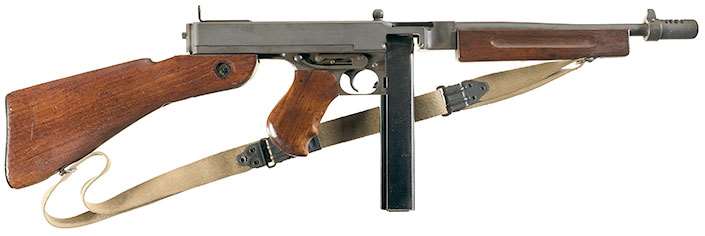
Another World War II combat veteran who was effusive in his praise for the Thompson was Carl H. Cartledge, Jr., a member of the 501st Parachute Infantry Regiment of the 101st Airborne Division, who saw extensive combat during the war. Cartledge wrote a lengthy positive critique regarding the Thompson in which he extolled the virtues of the .45 ACP cartridge and denigrated the effectiveness of the enemy’s 9 mm round. Several excerpts from the article he penned, titled “The Airborne Thompson; The Real Death From Above” follow: “I fell in love with the Thompson the first time I picked it up. TIME magazine called the Thompson ‘the deadliest weapon, pound for pound, ever devised by man.’ In combat, I found this to be an understatement … . I can tell you from experience that three rounds from a Thompson lifts a large man about six inches off the ground and drops him two feet from where he was hit. We found the MP40 to be a good gun and often used it against the Germans. The problem was one of our men hit with an MP40 went back to the aid station and rejoined the line in half an hour. [Once hit] with a Thompson, whether killed or not, [they] went nowhere. We felt, by experience, that a man with a 9 mm submachine gun was unarmed. … I would be remiss in not mentioning the respect the Thompson gained in France. France was the toughest, fiercest fighting of the war. Word spread quickly through the German ranks of ‘bastards in baggy pants’ and of our terrible Thompson gun. The Germans learned quickly that we had many of them and our use of them made the American gangster movies they had seen pale by comparison. The most chewed-up of Jerry’s wounded in field hospitals had been the lucky survivors of the American Thompson. ... I found the Thompson to be an almost perfect combat weapon right out of the crate … We found the Thompson particularly good at street fighting. A burst from General Thompson’s gun usually dismantled the doors in small European towns. The fight ended quickly.”
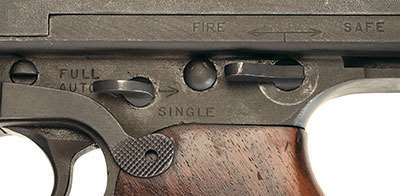
It might not be entirely accurate to state that the American combat troops of World War II had a “love-hate” relationship with the Thompson, but it cannot be denied there were strong feelings on both sides regarding it.
The Thompson’s merits as a military arm continues to be discussed, if not argued, even today. Numerous firsthand accounts both praise and condemn it. It was reported in one account that: “American paratroops, as soon as they could get their hands on a German Schmeisser, broke their Thompsons over the nearest rock; the roadside from Salerno to Naples was littered with Thompsons discarded by soldiers tired of carrying the heavy things.”
Another account stated that:
“[T]he Thompson was such a desirable weapon that infantry soldiers often bought or stole them from tank crews; when the new M3s arrived, many Marines would not turn in their battered but faithful Thompsons.”
The Thompson certainly possessed some obvious deficiencies, including its size, weight and cost compared to the later submachine guns made largely from stamped sheet metal. However, many of the criticisms leveled against it can be attributed to the soldier’s typical propensity to consider the enemy’s arms he had to face to be superior to his own. On the other hand, some infantrymen will, understandably, tend to venerate a gun that may have saved their lives during combat and overlook whatever deficiencies it may have otherwise possessed.
Whatever shortcomings it may have had, the Thompson was the only submachine gun available to our armed forces at the beginning of World War II, and it served through the end of the war. While still often thought of as a “gangster gun” to some, the Thompson submachine gun is, nonetheless, one of the most revered American infantry arms of World War II.
